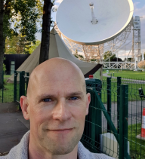current projects
Manchester-Besançon Microlensing Simulator (MaBμlS). We are a World leader in simulations of Galactic microlensing and their use in shaping the design of space-based microlensing surveys. Together with colleagues at Besançon Observatory we have developed the Manchester-Besancon Microlensing Simulator (MaBμlS). Our simulations provide a near perfect match to the observed distribution of microlensing events observed by ground-based surveys like OGLE-IV. We have pioneered new approaches that have led the design of the Euclid exoplanet survey. The same techniques are now also being used to design the exoplanet microlensing survey that will be a primary science objective for the NASA Nancy Grace Roman Space Telescope that is due for launch in 2025. An online version of MaBμlS is available as a community tool.
(Preprints/papers from this project)
Space-based microlensing detection of cool exoplanets. I am Deputy Lead of the ESA Euclid Exoplanets Working Group. Euclid is a medium-class ESA mission due for launch in 2022 whose primary science is the study of dark energy. But it is also expected to undertake other additional science activities, including a high cadence near-infrared search for exoplanets towards the Galactic bulge using microlensing. Such a survey would allow the mass, distance and motion of cool exoplanets to be determined down to Mars mass over exoplanet host separations ranging from 0.5 AU out to the free-floating exoplanet regime. This would provide the perfect complement to the hot and warm exoplanet census undertaken by the NASA Kepler transit mission. At Manchester we have led two major design studies of the Euclid exoplanet microlensing survey. We also work closely with members of Microlensing Science Investigation Team for the NASA Nancy Grace Roman Space Telescope. Roman will undertake an exoplanet microlensing survey as part of its core science activity after its launch in 2025. We have been involved in major design studies for the Roman microlensing survey, which has used simulations that were originated here at Manchester.
(Preprints/papers from this project)
SPEARNET - transmission spectroscopy of exoplanet atmospheres. The atmospheres of exoplanets that are detected using the transit method can potentially be studied using the method of transmission spectroscopy. Whilst in transit the light from the host star shines through the exoplanet atmosphere and may be absorbed or scattered at certain wavelengths. Observations of transits over a range of wavelengths enables us to build a transmission spectrum of the exoplanet atmosphere.
In collaboration with colleagues at the National Astronomical Research Institute of Thailand (NARIT) I have formed the Spectroscopy and Photometry of Exoplanet Atmospheres Research Network (SPEARNET). New ongoing and upcoming transit surveys such as NGTS, TESS and PLATO will be uncovering thousands of relatively nearby exoplanet systems that will be suitable for follow-up using techniques like transmission spectroscopy. We are therefore transitioning from a "target-starved" era of few suitable targets to an "asset-starved" era where there are insufficient ground-based telescopes available to follow-up all targets. SPEARNET uses a distributed network of optical telescopes to monitor transits at optical and near-infrared wavelengths. These observations allow a transmission spectrum of the exoplanet atmosphere to be obtained, allowing the study of clouds, hazes and alkali metals in the atmospheres of hot Neptunes and Jupiters that point to their internal chemistry. SPEARNET is pioneering an innovative approach of optimised automated selection of targets for study by a large globally-distributed network of telescopes of varying aperture. We are designing new powerful transit fitting codes suitable for multi-telescope, multi-wavelength, multi-epoch datasets. We are also innovating new machine-learning approaches for the retrieval of exoplanet atmosphere models from the observed data. These innovations will provide robust tools for future large-scale transmission spectroscopy surveys such as will be undertaken by the ESA Ariel mission, which is due for launch in 2028.
(Preprints/papers from this project)

 ORCiD
ORCiD